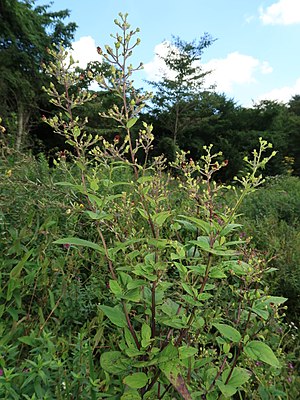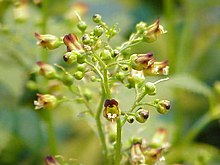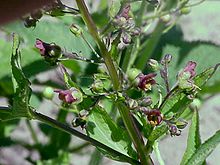Braunwurzen
| Braunwurzen | ||||||||||||
|---|---|---|---|---|---|---|---|---|---|---|---|---|

|
||||||||||||
| Systematics | ||||||||||||
|
||||||||||||
| Scientific name | ||||||||||||
| Scrophularia | ||||||||||||
| L. |
The figwort ( Scrophularia ) are a genus of plants in the fig family (Scrophulariaceae).
description




The genus Scrophularia is roughly divided into two groups. One group contains biennial or perennial herbaceous plants whose stems are at most slightly branched at the bottom and are not lignified. The side veins going away from the central rib of the leaf are connected to one another by side veins of the second order, so that a reticulate vein is created. The always polyploid representatives of this group are found mainly in the temperate latitudes of the northern hemisphere .
In the other group, mainly native to the Himalayas , the side veins of the foliage leaves are unbranched. The stems of the plant species in this group lignify at the bottom, in the ground, and are often heavily branched. These species are always diploid. Some are subshrubs .
The stem is square, with many species also winged. The leaves are opposite, in some species in the uppermost part of the plants also alternate. As a rule, the leaf blades are roughly triangular and serrate or notched.
Inflorescences and flowers
The paniculate , racemose , zymous or balled inflorescences are usually at the end of the stems, but can also be in the leaf axils.
The rather inconspicuous flowers are zygomorphic and usually five-fold. The five sepals are only fused at their base. The five brownish to dirty red petals are fused with tubes. The short and wide corolla tube, also greenish at the base, ends clearly with two lips. The lower lip is divided into three short lobes, two of which stand upright on the side, while the middle lobe is directed straight forward. The longer upper lip is divided into two rounded lobes. There are four fertile stamens . There is a scaly staminodium per flower or it is rarely absent. There is a discus. It is usually at least as long as the ovary; only in Scrophularia urticifolia is it shorter. The mostly relatively small scars are cephalic to bilobed.
Fruits and seeds
The capsule fruits contain many seeds.
Occurrence
The figwort species can be found all over the northern hemisphere in the temperate latitudes up to southern Asia. The center of diversity (center of biodiversity ) is the Himalaya . Only a small fraction of the species is found in Europe and North America .
While the diploid clans prefer dry locations, the polyploid species that grow outside of the Himalayas are often found in sparse forests, in bushes or in more or less humid herbaceous vegetation.
The following species are found in Central Europe: water figwort ( Scrophularia auriculata ), dog figwort ( Scrophularia canina ), Hoppes figwort or alpine figwort, alpine figwort ( Scrophularia juratensis ), gnarled figwort or common figwort ( Scrophularia nodosa ), Glandular figwort or Scopoli figwort ( Scrophularia scopolii ), winged figwort ( Scrophularia umbrosa ), spring figwort ( Scrophularia vernalis ).





Systematics
The genus Scrophularia was established by Carl von Linné . Scrophularia nodosa L. was specified as the lectotype species by Nathaniel Lord Britton and Addison Brown in An Illustrated Flora of the Northern United States , 2nd edition, 3, page 179 in 1913 .
The figwort was previously used as a remedy for the scrophula , a form of tuberculosis ; hence the genus got its scientific name Scrophularia .
Depending on the opinion, the genus Scrophularia contains between 120 and more than 300 species (selection):
- Scrophularia aequilabris P.C.Tsoong : It grows in forests at altitudes from 3,300 to 3,900 meters in the western Sichuan .
- Scrophularia aestivalis Griseb. (Syn .: Scrophularia autumnalis Formánek , Scrophularia silvatica Boiss. & Heldr. ): It occurs in Serbia, Albania, Bulgaria and Greece.
- Scrophularia alaschanica Batalin : It thrives at altitudes of 2200 to 2500 meters only in the Chinese province of Ningxia .
- Scrophularia alata A.Gray (Syn .: Scrophularia grayana Maxim. Ex Kom. ): It occurs in Korea , in Russia's Far East in the Primorye region , on Sakhalin as well as on the Kuriles and on the Japanese islands of Hokkaido and Honshu .
- Scrophularia alpestris Benth. (Syn .: Scrophularia oblongifolia Merino ): It occurs in Spain and France.
- Scrophularia amana Lall : It occurs in the Asian part of Turkey .
- Scrophularia amplexicaulis Benth. : It occurs in Armenia and Turkey.
- Scrophularia arguta Aiton : It occurs in Morocco, Algeria, Tunisia, Libya, Egypt, Spain, on the Canary Islands and on Selvagens .
- Scrophularia atropatana Grossh. : It occurs in Armenia.
- Water figwort ( Scrophularia auriculata L. ): It occurs in Morocco, Algeria, Tunisia, the Canaries and Azores, in Portugal, Spain, France, Italy, in Great Britain, Ireland, Belgium, in the Netherlands, Germany, in Switzerland and in Crete.
- Scrophularia benthamiana Boiss. : It occurs in Armenia.
- Scrophularia bitlisica Lall : It occurs in the Asian part of Turkey.
- Brownwort ( Scrophularia canina L. )
- Yellow-flowered figwort or poppy bun flower ( Scrophularia chrysantha Jaub. & Spach ): It is native to Turkey and Armenia.
- Shrubby figwort ( Scrophularia frutescens L. ): It is also known as the subspecies Scrophularia canina subsp. frutescens (L.) O.Bolòs & Vigo to Scrophularia canina .
- Scrophularia heterophylla Willd. : It occurs on the Balkan Peninsula, Romania, Bulgaria, Ukraine, Turkey, the Aegean Sea and the Sinai Peninsula.
- Hoppes figwort or Alpen-Hunds-Braunwurz, Alpen-Braunwurz ( Scrophularia juratensis Schleicher )
- Scrophularia lucida L .: It occurs in France, Italy, Greece, Syria, Turkey, the Caucasus and in Saudi Arabia.
- Knotty figwort or common figwort ( Scrophularia nodosa L. ), the most common species in Central Europe .
- Stranger Figwort ( Scrophularia peregrina L. ): It occurs in Portugal, Spain, France, Italy, Sardinia, Sicily, Malta and Corsica, in Tunisia, Libya, on the Balkan Peninsula, in Turkey, Aegean Sea, Syria, in Lebanon and in Cyprus in front.
- Scrophularia ramosissima Loisel. : It occurs in Morocco, Tunisia, the Balearic Islands, France, Corsica, Sardinia, Sicily and Albania.
- Glandular figwort or Scopoli figwort ( Scrophularia scopolii Hoppe ): It occurs in Austria, Poland, the Czech Republic, Slovakia, Hungary, Italy, Slovenia, Serbia, Croatia, Albania, Bulgaria, Greece, Romania, Moldova, in the Ukraine, in Turkey, Syria, Lebanon, Iraq, Iran and the Caucasus.
- Trifoliate figwort ( Scrophularia trifoliata L. ): It occurs in Italy, Sardinia and Corsica.
-
Winged figwort ( Scrophularia umbrosa Dumort. ): With the subspecies:
- Common wing Figwort ( Scrophularia umbrosa Dumort. Subsp. Umbrosa )
- Notched winged figwort ( Scrophularia umbrosa subsp. Neesii (Wirtgen) E. Mayer )
- Spring figwort ( Scrophularia vernalis L. )
literature
- Deyuan Hong, Hanbi Yang, Cun-li Jin, Manfred A. Fischer, Noel H. Holmgren, Robert R. Mill: Scrophularia. In: Wu Zheng-yi, Peter H. Raven (Ed.): Flora of China . Volume 18: Scrophulariaceae through Gesneriaceae . Science Press / Missouri Botanical Garden Press, Beijing / St. Louis 1998, ISBN 0-915279-55-X , p. 11 (English). , PDF file , online. (engl.)
- WR Barker: Scrophularia. In: Gwen J. Harden (Ed.): Flora of New South Wales. Volume 3, New South Wales University Press, Kensington 1992, ISBN 0-86840-172-2 , p. 573, limited preview in Google Book Search, online (with minor changes ).
- Ian Bertram Kay Richardson: Scrophularia L. In: TG Tutin, VH Heywood, NA Burges, DM Moore, DH Valentine, SM Walters, DA Webb (Eds.): Flora Europaea . Volume 3: Diapensiaceae to Myoporaceae . Cambridge University Press, Cambridge 1972, ISBN 0-521-08489-X , pp. 216–220 (English, limited preview in Google Book Search).
Individual evidence
- ↑ a b c d e Deyuan Hong, Hanbi Yang, Cun-li Jin, Manfred A. Fischer, Noel H. Holmgren, Robert R. Mill: Scrophularia. , P. 11 - online with the same text as the printed work , In: Wu Zheng-yi, Peter H. Raven (Ed.): Flora of China. Volume 18: Scrophulariaceae through Gesneriaceae. Science Press and Missouri Botanical Garden Press, Beijing and St. Louis 1998, ISBN 0-915279-55-X .
- ^ Scrophularia at Tropicos.org. Missouri Botanical Garden, St. Louis. Retrieved December 23, 2017.
- ↑ a b c d e f g h i j k l m n Karol Marhold, 2011: Scrophulariaceae. : Datasheet Scrophularia In: Euro + Med Plantbase - the information resource for Euro-Mediterranean plant diversity.
- ^ A b c d Scrophularia in Germplasm Resources Information Network (GRIN), USDA , ARS , National Genetic Resources Program. National Germplasm Resources Laboratory, Beltsville, Maryland. Retrieved December 20, 2017.